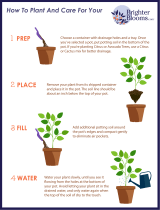Page is loading ...

Citrus Growing
When to plant
Generally, citrus trees can be planted any time of year, depending on the specific climate, but
should be planted so that the roots have a chance to acclimatize before extreme temperatures are
expected.
Where to plant
Citrus can be planted in containers indoors or outdoors, or in the ground. Soil pH should be
slightly acidic to about neutral (6.0 to 7.5) and soil depth should be a minimum of 18 inches
deep. Sandy to clay loam soils are best, with good drainage a must.
A site in full sun protected from severe wind is best. Be aware that some types, such as
grapefruit, require more heat to produce sweet, tasty fruit. Planting higher on a slope can provide
some protection from cold air.
Transplanting from a container to the ground
Handle the tree gently and protect the roots from damage. Dig a hole about twice as wide as the
rootball of the tree and about the same depth as the rootball. Save the soil for backfill; break up
large clumps. Soil amendments are not recommended unless the soil is extremely sandy or is
heavy clay.
Trees should be planted at the same depth as they were in the container. If planted too deep, soil
and water tend to stand against the trunk, which promotes root and crown rots such as
Phytophthora. If planted too high, the roots will dry out too quickly.
Planting in a Container
To create the ideal growing medium for citrus, start with a commercially available soil mix that
does not contain chemical wetting agents. Evenly combine a 1/4 – 1/3 volume of redwood or
cedar shavings with the commercial soil mix, cedar hamster bedding is widely available and
inexpensive.
Use a container that allows for good drainage and has at least five drainage holes. When planted
at the correct height the thicker woody “crown” roots will show just at or above the soil line and
the fine feeder roots below will be covered with soil. Do not cover the trunk with soil. Putting
gravel on the bottom of the pot can impede drainage, so is not recommended.
Watering
Citrus trees require consistently moist but not soggy soil and they do not like standing water. The
root system should not be allowed to dry out, which stresses the tree. Note however, that
overwatering and/or poor drainage are also problems, and equally stressful. Citrus trees are
evergreen, and should be irrigated year-round, especially during active growth periods, usually
late winter or early spring through summer. Young trees with a trunk diameter of less than an
inch are especially vulnerable to irrigation issues. Irrigation should be at the root zone area away

from the trunk and the bud union to avoid fungal diseases. Newly planted trees should be
irrigated well immediately after planting to ensure surface roots stay moist.
Irrigation Frequency
Irrigation frequency is influenced by weather, so the irrigation schedule should be adjusted
throughout the year. Irrigation efficiency is also influenced by soil type. Generally, irrigate when
the top few inches of the soil are dry and the rest of the root zone is slightly moist. Young trees
should be irrigated at least every 5 to 10 days during the summer months, or more frequently if
the root system dries out, and more frequently in hot, dry and windy conditions. Mature trees
require less frequent irrigation. Irrigation should also be less frequent when the weather is cool or
overcast.
Irrigation Amount
In general, 2 to 5 gallons of water should be applied to a newly planted tree at each watering, as
long as there is no standing water and the soil is not soggy. Established trees should be watered
so that the entire root zone is moist. A soil probe is a useful tool to determine the depth of
irrigation. The soil should be sampled to a depth of about 12 inches to determine soil moisture
content.
A mature tree with an extensive root system requires more water to wet its larger root zone than
a young tree with a smaller root mass. However, the root system of a young tree dries out more
quickly.
Fertilizing
To ensure good crops, the tree needs adequate nutrition. Nutrient deficiencies reduce yield and
adversely affect size, color, sweetness and peel texture of fruit. Typically, nitrogen is the nutrient
most often required. In some soils, other minerals may be deficient. A soil analysis can be
helpful. A complete organic citrus fertilizer with adequate nitrogen will generally supply
the other required nutrients such as iron, zinc, magnesium, phosphorus, potassium.
Trees in Containers
Since trees in containers need to be irrigated more frequently than trees in the ground, they also
require more frequent applications of fertilizer. A complete (nitrogen plus other nutrients), slow-
release fertilizer is recommended; apply per the label instructions. Chelated iron is also more
often required for container grown trees and should be applied per the label instructions.
Protect from sun
In very hot, sunny areas, protect the trunk and large limbs from sunburn, particularly after
pruning that exposes limbs to the sun. Lemons are especially susceptible. Wrap the trunk of a
newly planted tree with newspapers or tree wraps and tie loosely. Paint the trunks and exposed
limbs of older trees with white, water-based latex paint diluted 1:1 with water.
Protect from frost
Young citrus trees are susceptible to frost damage. For short-term protection of the trunk, options
include an insulating wrap of corrugated cardboard, several layers of newspapers, corn stalks, or
thermal wraps. Wrap to a point above the bud union. If the tree suffers frost damage, do not cut

away damaged parts until new growth is established in the spring. Do not use plastic to cover
tree trunks or foliage.
/








